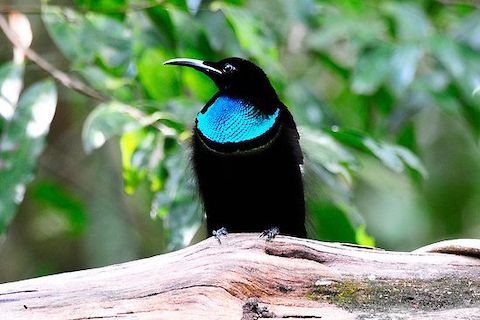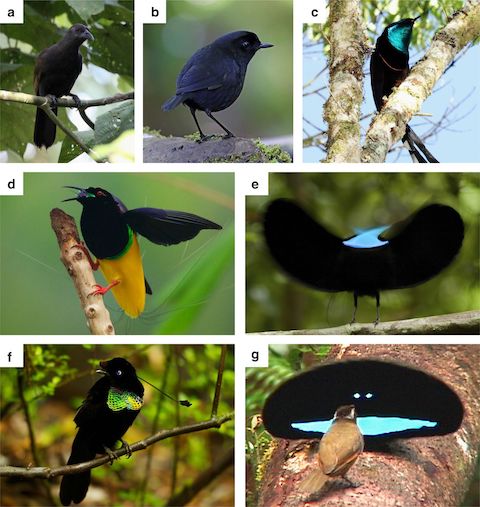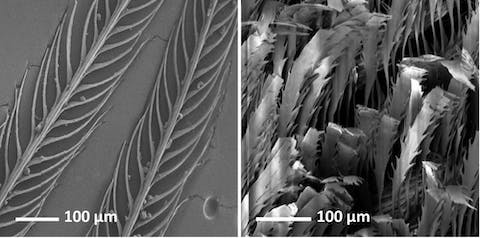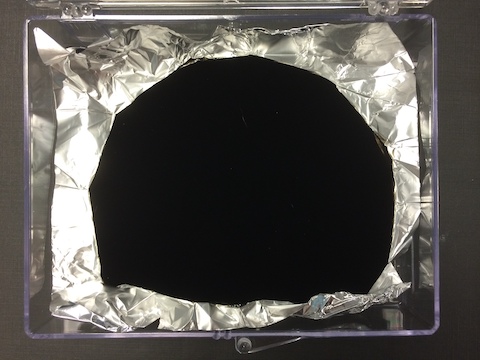
When you see white, you’re actually seeing all the visible colors of light at once.
And when you see black, the object you’re looking at is absorbing light.
White and black aren’t colors; they’re visual experiences.
And a few rare animals can produce the visual experience of super-black.
Most black surfaces are still slightly reflective. But these creatures have developed plumage or cells that absorb nearly all visible light.
The male birds of paradise in Papua New Guinea have super-black feathers that, when examined with an electron microscope, have a three-dimensional structure like miniature bottle brushes.
Their complex surfaces scatter and trap light until it’s absorbed and converted into heat energy.
Even if these feathers are coated in shiny metal, they remain super-black—because it’s their structure, not a pigment, that’s absorbing the light.
Super-black is so dark that features, angles, and textures disappear.
So some birds, butterflies, spiders, and snakes use it as camouflage or to attract mates—making their brightly colored areas appear even more vivid.
Today, scientists may be able to do them one better, creating ultra-black with carbon nanotubes, which would capture 99.995 percent of visible light, and infrared too.
It could be used to camouflage military vehicles or keep stray light from bouncing into telescopes.
Just one more instance of humans taking a visual cue from nature.
Background
Synopsis: White is the presence of all the colors of the visible spectrum, and black is the absence of colors from the visible spectrum. White and black are actually not colors, they are visual experiences. Both nature and man have developed ways to make black even blacker for a variety of reasons.
- In art, we think of white and black as colors, but in physics, they are not colors.
- Visible light is electromagnetic radiation with wavelengths that range from about 400–700 nm. When we see a color, we see a specific wavelength of visible light reflected into our eyes.
- When we see white, we are viewing all wavelengths of visible light simultaneously.
- But when we experience black, the object is absorbing almost all the wavelengths of visible light and the heat that comes along with them.
- This is why darker clothing and cars heat up more than those with lighter colors. Researchers even found that dark-colored cars use 2% more fuel to power their air conditioners.
- In nature, there is black, and there is super-black.
- Most black-colored surfaces reflect a small percentage of light, but there are some creatures whose velvety black coats absorb almost all light from the visible spectrum.

- Male riflebirds from Australia have velvety deep-black feathers that absorb 99.95% of light.
- When examined using a scanning electron microscope, these super-black feathers look different than typical flat bird feathers: they stick up in a 3D pattern that looks like miniature bottle brushes.
- Just like black velvet or black velour fabrics have a deeper black appearance, the feathers’ complex microscopic surfaces scatter and trap light when it hits their jagged surfaces until it is completely absorbed and converted to heat energy.

- Super-black is such a profoundly deep black that it looks like a void.
- Even angular surfaces seem to disappear because without reflected light, no edges can be discerned.
- Even if they are coated in a shiny metal, super-black feathers still look black because pigment is not involved—it is the structure of the surface that absorbs the light so completely that it results in our perception that the feather is black.
- Other creatures, like some butterflies, spiders, and snakes, also display super-black features. Some use super-black to enhance a 3D type of camouflage. Others use it for mating purposes. Super-black enhances the effect of any vivid or iridescent colors displayed near it, making the colors appear like they are lighting up on their own.
- Humans have also created a super-black material that absorbs 99.965% of visible light. It’s called Vantablack.
- Surrey Nanosystems, a British company, paired with NASA and the U.K. National Physical Laboratory to create a method to grow a dense thicket of vertical carbon nanotubes at temperatures of around 750°F (400°C).
- The “vanta” in Vantablack stands for vertically aligned carbon nanotube arrays.
- The material absorbs light so completely that a laser dot disappears when directed at its surface.
- It is so dark that it turns an otherwise 3D object into a flat black void.
- The material was originally designed for aerospace applications, such as on spaceships or satellites where reflecting light can cause issues.
- Besides aerospace applications and just blowing our minds by making us think we’re looking into a black hole, items coated with Vantablack also have practical uses such as camouflaging military vehicles, keeping extraneous light out of telescopes, increasing the sensitivity of infrared photography, and increasing the amount of light collected by solar panels.
- Commercial uses so far consist of expensive watches and cars.
- New materials are being developed that absorb even more light—up to 99.995% of incident light. The key to creating the next ultra-black is to absorb light across not only the visible spectrum, but across the far infrared spectrum also, which might require preparation at temperatures as high as 1400°F (760°C).


